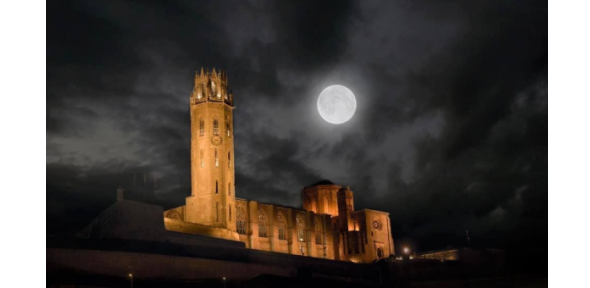This paper will be running in the academic year 2023-2024.
Introduction
This hybrid paper aims to provide the students with a comprehensive knowledge of Catalan cultures and Catalan language.
The cultural part of Sp10 offers an extensive introduction to the literature and culture of Catalonia and other Catalan-speaking regions and countries, most notably Valencia and the Balearic Islands. Consisting of fourteen lectures (combined with the supervisions), this course will examine major tendencies in literature, architecture, sociolinguistics, politics, history, film and the visual arts.
The paper is divided into three cultural sections, ordered chronologically. The first is devoted to the “re-birth”, consolidation and diversification of linguistic, cultural and national consciousness from the romantically inflected Renaixença to the internationally orientated Avant-Garde (c.1833-1936), with an emphasis on poetry, linguistic politics, urban planning, architecture, painting, photography and World’s Fairs. The second period focuses on cultural production during the Franco dictatorship (1939-1975), with special attention to literature and film. The final section addresses questions of constitutional democracy, postmodernism and globalism, with reference to cinema, theatre, poetry and prose fiction.
The language part will provide two weekly advanced language classes that will prepare the students to obtain a B2/C1 level in Catalan. The aim of the language component of the SP10 paper is to equip students as proficient users of the Catalan language, able to understand a wide range of demanding, long texts, and recognise implicit meaning. Students will be able to express themselves fluently and spontaneously without much obvious searching for expressions, as well as to use language flexibly and effectively for social, academic, and professional purposes. As for the written language, students will work on their skills to produce clear, well-structured, detailed text on complex subjects, showing controlled use of organisational patterns, connectors, and cohesive devices.
I. Renaixença, Modernisme, Noucentisme and the Avant-garde
1. The Renaixença and the Jocs Florals: Poetry from Aribau to Verdaguer.
2. Alternative Geographies and Affects in Àngel Guimerà’s Terra Baixa.
3. Modernisme: Joan Maragall, “la paraula viva” and Civic Engagement.
4. Noucentisme, Nationalism, Language and the Institutionalisation of Culture.
II. The Civil War and the Francoist Dictatorship
5. Visualising and Recording Revolution and Civil War: Aurora de Esperanza (Sau Olite), Barrios bajos (Pedro Puche), El entierro de Durruti (1936) and the war photography of Agustí Centelles.
6. Transatlantic Gazes: Exile and Nostalgia in Ramon Vinyes.
7. Gabriel Ferrater and the Poetics of Intertextuality: Carles Riba, Josep Carner.
8, 9. Civil War, Memory, Home: The Politics of Everyday Life in Mercè Rodoreda’s La plaça del Diamant. (2 sessions)
III. Democracy and Globalization
10. Queerness and Nationality: The Poetics of Maria-Mercè Marçal and Biel Mesquida.
11. Memory and Trauma of the Civil War: Helena Tornero's No parlis amb estranys
12. Other Borders: Peripheric Gazes in Carla Simón’s Alcarràs.
13. Branding the City: Tourism, Fashion, and Urban Development in the Olympic and Post-Olympic Barcelona.
14. On Race and Heritage: Catalan Black Theatre and Performance.
- Bou, Enric; Jaume Subirana (ed.). The Barcelona Reader. Cultural Readings of a City. Ajuntament de Barcelona / Liverpool University Press, 2017.
- Dowling, Andrew. Catalonia: A New History. London and New York: Routledge, 2022.
- Castellanos, Jordi; Jordi Marrugat (ed.). Història de la literatura catalana. Vol. VI. Modernisme. Noucentisme. Avantguardes. Enciclopèdia Catalana / Barcino / Ajuntament de Barcelona, 2020.
- Keown, Dominic (ed.). A Companion to Catalan Culture. Tamesis, 2011.
- Terry, Arthur. A Companion to Catalan Literature. Tamesis, 2003.
- Vilarós, Teresa M. “A cultural mapping of Catalonia.” David T. Gies (ed.) The Cambridge Companion to Modern Spanish Culture. Cambridge UP, 1999. 37-53.
CULTURAL PART
Instruction in this paper will consist of fourteeen lectures and supervisions focused on each of the three periods. Students will be examined are thus expected to study works from all three historical periods, four to five lectures devoted to each.
LANGUAGE PART
The language component will be covered in two one-hour long weekly sessions (16 in Michaelmas, 16 in Lent, 8 in the first four weeks of Easter), adding to 40 hours.
The content will be structured in thematic units, which will revolve around the achievement of a communicative task. The completion of the task will imply the deployment of a set of cultural, communicative, and discourse content, together with grammar, vocabulary and phonetic items corresponding to the level students are expected to achieve. The organisation of the language component of the paper is going to follow, as closely as possible, the logics of the deployment of the cultural component of the paper, so that the linguistic component established an enriching dialogue with cultural and literary topics covered in the other component of the paper. Specifically, the syllabus of the language component has been designed to match both the comprehension and production skills required to students in the cultural part of the paper.
Candidates enrolled on this course will be of intermediate language level having successfully completed SP6 at IB or satisfied the Director of Section of their appropriate linguistic proficiency in Catalan.
CULTURAL PART
Assessment for the cultural part of Sp10 consists of a standard three-hour end-of-year examination. It will be of comparative nature, and one question will be answered from each of the paper’s three sections.
LANGUAGE PART
The language exam is a standard Cambridge test, consisting of several exercises to test grammar, vocabulary, and verbal tenses, plus a question on translation, synthesis, and commentary in Catalan.
Dr. Isaías Fanlo (cultural component) | |
Dr. Ares Llop (language component) |




